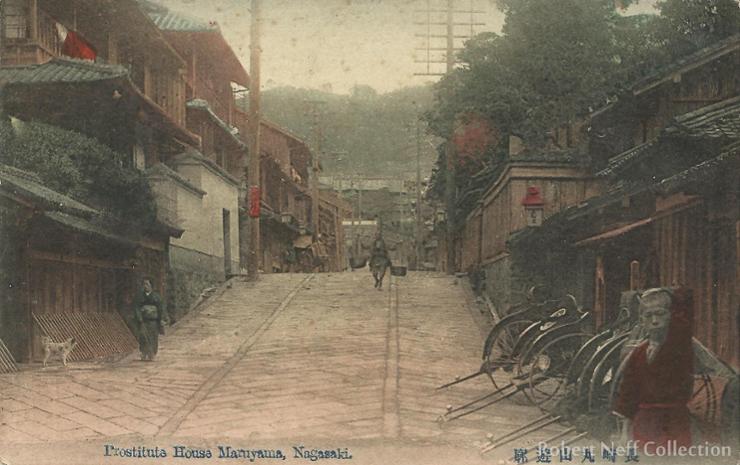
A view of Nagasaki in the late 19th century / Robert Neff Collection
By Robert Neff
In the early summer of 1897, a dog named Jack became a well-known figure in Nagasaki, described as “one of the most singular characters’ in the port. By lineage, Jack was a mongrel, the product of “indiscreet flirtations on the part of some gentle hearted Newfoundland” with a chow chow from Canton. For the most part, he was white, but he bore “a patch of brown over either ear, and another similar patch where his [kinky-curled] tail meets the rest of him.” According to the editor of an English-language newspaper in the port, Jack was “for all intents and purposes, a beach-comber, though a sober one.” He had “a marked predisposition” for following British marines and sailors while they were ashore on leave.
Jack had a particular affinity for the British navy. In the mid-1890s, he was acquired in one of the southern Chinese treaty ports and became the unofficial mascot aboard the British torpedo cruiser HMS Archer. Although “a particularly ordinary” pup in appearance, “his good nature and apparent absence of moral responsibility won him many friends” amongst the crew.

The British warship HMS Severn in Nagasaki in the late 19th century / Robert Neff Collection
Jack was also remarkably brave and impulsive. In the summer of 1896, while HMS Archer was anchored at Hong Kong, an inexperienced Chinese grocer’s boy was delivering vegetables to the ship when he suddenly slipped and tumbled overboard. Unable to swim in what, to him, was an “unnatural element,” it appeared he would drown. Without hesitation, Jack bounded over the railing and into the sea.
Jack grabbed the desperately floundering boy and kept him afloat — despite the possible threat of sharks — until members of the crew could rescue them both. Jack was a hero.
However, Jack was “no ornament [confined solely] to the cruiser.” When the ship arrived in Nagasaki in the fall of 1896, Jack developed “a depraved knack of sneaking ashore with the liberty men on general leave.” He “frittered away” his time with the “less godly” members of the crew in the “low haunts” of Nagasaki, only to return to the dock the following noon to catch the regular launch back to the ship.

Sailors from HMS Carlisle during a visit to Nagasaki in 1921 / Robert Neff Collection
One day, however, Jack returned to the dock but could not find the launch. While frolicking alone in the seedier sections of the port, the cruiser had suddenly received orders and departed, leaving behind the poor pup to fend for himself.
For several days, Jack waited at the pier for the ship to return, but he eventually accepted the fate of his dereliction. “He was readily recognized by the men of the various warships who were ever ready to toss him a crust [of bread] or a bone” during their shore leave and welcomed his company as they took in the sights. The merchants of Nagasaki quickly recognized his charm and a fierce rivalry developed amongst them as they courted Jack’s patronage. “As a result [Jack] waxed big and fat” and became “a homeless nomad, a beachcomber” in the port.

A popular spot in Nagasaki for visiting sailors in the late 19th and early 20th centuries / Robert Neff Collection
When no British marines or sailors were ashore, Jack would go to the pier day after day, scanning the harbor for a white ensign. According to the newspaper’s editor, “By some inscrutable canine instinct, [Jack could] tell a Britisher afar off, and when he [saw] one of Her Majesty’s ships he [was] all uneasiness until he [could] board her.”
Impatiently, he would wait for a boat to take him to the ship, but when his patience ran out, he would jump into the water and begin swimming. “It is an extraordinary thing,” remarked the editor, “to see this big kinky-tailed brute take the water in quite a matter-of-fact sort of way and start out — often against wind and tide — for a half mile swim to some warship.”

After a hard night of drinking, some British sailors found themselves before their consul at Nagasaki. Robert Neff Collection
Once alongside the ship, Jack was carefully hoisted aboard, much to the delight of the crew. After taking a few minutes to “freshen up,” he would promptly challenge the ship’s dog to a fight — “getting licked as often as not.” If permitted, Jack would spend the night aboard, and the next morning, if no boat was available, he would swim ashore to make his daily rounds while awaiting the arrival of sailors and marines on leave.
What became of Jack is unknown. His biographer, the newspaper editor, suffered a nervous breakdown and passed away in the fall of 1897. The newspaper was subsequently purchased by a rival, and the new editor likely deemed Jack’s exploits “too stale to be interesting” enough to merit further coverage. He was mistaken. Sometimes a tale of a dog’s life is precisely what is needed to balance the misery that so often dominates the news.
I would like to express my sincere appreciation to Diane Nars for her invaluable assistance.
Robert Neff has authored and co-authored several books, including Letters from Joseon, Korea Through Western Eyes and Brief Encounters.


















 English (United States) ·
English (United States) ·